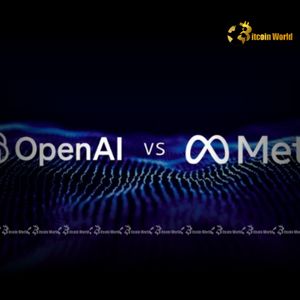BitcoinWorld Meta AI Accelerates Talent Acquisition: Why Top OpenAI Researchers Are Making the Switch In the rapidly evolving landscape of artificial intelligence, where innovation drives market dominance and shapes the future of technology, the battle for top-tier expertise is fiercer than ever. For those in the cryptocurrency space, understanding these shifts in the broader tech ecosystem is crucial, as advancements in Meta AI , for instance, often pave the way for new blockchain applications, decentralized AI, and Web3 innovations. A recent development highlights this intense struggle: Meta’s relentless pursuit of talent from rival OpenAI, signaling a significant escalation in the ongoing AI arms race. This strategic move by Meta is not just about expanding its team; it’s a bold declaration of intent in the quest for AI supremacy. The Escalating Meta AI Talent War: Who’s Moving Where? The tech world is abuzz with reports confirming Meta’s aggressive recruitment strategy, particularly targeting the crème de la crème of OpenAI researchers . Earlier reports highlighted the acquisition of influential OpenAI researcher Trapit Bansal, along with three other undisclosed talents. Now, new information reveals four more significant hires: Shengjia Zhao, Jiahui Yu, Shuchao Bi, and Hongyu Ren. These individuals are not just ordinary engineers; they are key contributors to some of the most advanced AI models and research breakthroughs. Their transition to Meta underscores a pivotal moment in the competitive landscape of artificial intelligence. This isn’t merely a series of isolated incidents; it’s part of a broader pattern of strategic talent acquisition that reflects the high stakes involved in developing next-generation AI. The movement of such high-profile individuals can significantly impact the trajectory of AI development within both companies, potentially shifting the balance of power in areas like large language models, generative AI, and advanced machine learning research. Why are Top OpenAI Researchers Making the Leap to Meta? The motivations behind such high-profile transitions are often complex, encompassing more than just financial incentives. While OpenAI CEO Sam Altman’s provocative suggestion of Meta offering “$100 million signing bonuses” certainly grabbed headlines, Meta CTO Andrew Bosworth clarified that “the actual terms of the offer” were more nuanced than a simple one-time bonus, implying a comprehensive package of compensation, equity, and long-term incentives. However, beyond the monetary aspect, several factors could be at play: Project Scope and Ambition: Meta, under Mark Zuckerberg’s ambitious vision, is heavily investing in AI to power its metaverse initiatives, social media platforms, and new consumer products. This could offer researchers opportunities to work on large-scale, impactful projects with vast real-world applications. Resource Access: Meta boasts immense computational resources, vast datasets, and a global user base, providing an unparalleled sandbox for AI development and deployment. For researchers, access to such infrastructure can accelerate their work and bring their innovations to a massive audience. Research Freedom: While both companies are at the forefront of AI research, differing organizational cultures or strategic priorities might offer a more appealing environment for certain researchers. The ability to pursue specific research interests or contribute to a different kind of AI ecosystem could be a strong draw. Team Dynamics: The opportunity to collaborate with a new set of brilliant minds or to lead specific initiatives within Meta’s growing AI division might also be a significant factor for these AI talent acquisitions. The Llama 4 Imperative: Meta’s Ambitious AI Vision This aggressive hiring spree comes on the heels of the April launch of Meta’s Llama 4 AI models. While Llama 4 represented a significant step forward for Meta in the generative AI space, reports indicated that its performance did not quite meet CEO Mark Zuckerberg’s high expectations. Furthermore, the company faced criticism regarding the version of Llama used for a popular benchmark, raising questions about its competitive standing. The influx of seasoned OpenAI researchers is clearly intended to bolster Meta’s capabilities, particularly in refining and advancing its Llama series. These new hires bring a wealth of experience in developing state-of-the-art large language models, fine-tuning their performance, and optimizing them for various applications. Their expertise is crucial for Meta to: Improve the foundational architecture and training methodologies of future Llama models. Enhance the safety, reliability, and ethical deployment of Meta’s AI systems. Accelerate the development of new generative AI features for its vast ecosystem of products. Ensure that Llama 4 and its successors can truly compete with, and potentially surpass, leading models from rivals like OpenAI and Google. This investment signifies Meta’s unwavering commitment to becoming a dominant force in the AI domain, seeing it as foundational to its future growth and its metaverse vision. Navigating the Intense AI Competition Landscape The movement of AI talent between Meta and OpenAI is a vivid illustration of the intense AI competition currently defining the tech industry. This isn’t just a corporate rivalry; it’s a strategic battle for intellectual property, innovative breakthroughs, and ultimately, market leadership. Every major tech giant, from Google to Microsoft (with its significant investment in OpenAI), Amazon, and Apple, is pouring billions into AI research and development. This competitive environment drives rapid innovation but also raises questions about talent sustainability and the potential for a “brain drain” from one company to another. The implications extend beyond just product development; they touch upon the future of open-source AI, the ethical guidelines governing AI development, and the overall pace at which artificial intelligence will integrate into our daily lives. Consider the competitive landscape: Aspect Meta (AI Division) OpenAI Primary Focus AI for Metaverse, Social Platforms, Generative AI (Llama series) General AI, Large Language Models (GPT series), Image Generation (DALL-E) Funding/Support Internal R&D, Mark Zuckerberg’s vision Significant investment from Microsoft, venture capital Recent Challenges Llama 4 performance concerns, benchmark criticism Scaling challenges, ethical considerations, high operational costs Talent Strategy Aggressive recruitment, internal growth Retention of key researchers, attracting top global talent This table highlights that while both companies are at the forefront, their strategic paths and immediate challenges differ, making the cross-pollination of talent particularly impactful. What Does This Mean for the Future of AI Talent and Innovation? The aggressive recruitment of OpenAI researchers by Meta signals a few key trends for the future of AI. Firstly, the value of specialized AI talent is at an all-time high, creating a fiercely competitive job market where top researchers command significant compensation and influence. Companies are willing to go to extraordinary lengths to secure the brightest minds, understanding that human capital is the ultimate differentiator in the AI race. Secondly, it suggests that the race to build the most capable and widely adopted AI models is intensifying. Meta’s push with Llama 4 and subsequent versions indicates a strategic effort to establish its own robust AI ecosystem, reducing reliance on third-party models and strengthening its position against competitors. This could lead to a more diverse range of powerful AI models available, potentially fostering greater innovation and specialized applications across industries, including new opportunities for crypto and Web3 developers leveraging these advanced models. Finally, this talent migration could lead to a cross-pollination of ideas and methodologies, potentially accelerating breakthroughs across the board. Researchers bringing their unique perspectives and experiences from one leading AI lab to another can foster new approaches and solutions, benefiting the entire field of artificial intelligence. It underscores that the ultimate winners in this AI arms race will be those who can not only innovate rapidly but also attract, retain, and effectively deploy the most brilliant minds in the field. In conclusion, Meta’s strategic hiring of top OpenAI researchers is more than just a series of job changes; it’s a potent symbol of the escalating AI competition that is reshaping the technological landscape. As companies vie for supremacy in artificial intelligence, the movement of elite AI talent will continue to be a critical indicator of who is poised to lead the next wave of innovation. For the crypto community, these developments in core AI research are foundational, influencing everything from secure smart contracts to advanced trading algorithms and decentralized autonomous organizations. The battle for AI talent is indeed a battle for the future itself, promising unprecedented advancements and transformative changes across all sectors. To learn more about the latest AI market trends, explore our article on key developments shaping AI Models features. This post Meta AI Accelerates Talent Acquisition: Why Top OpenAI Researchers Are Making the Switch first appeared on BitcoinWorld and is written by Editorial Team



















